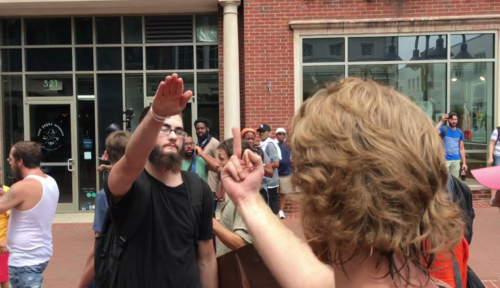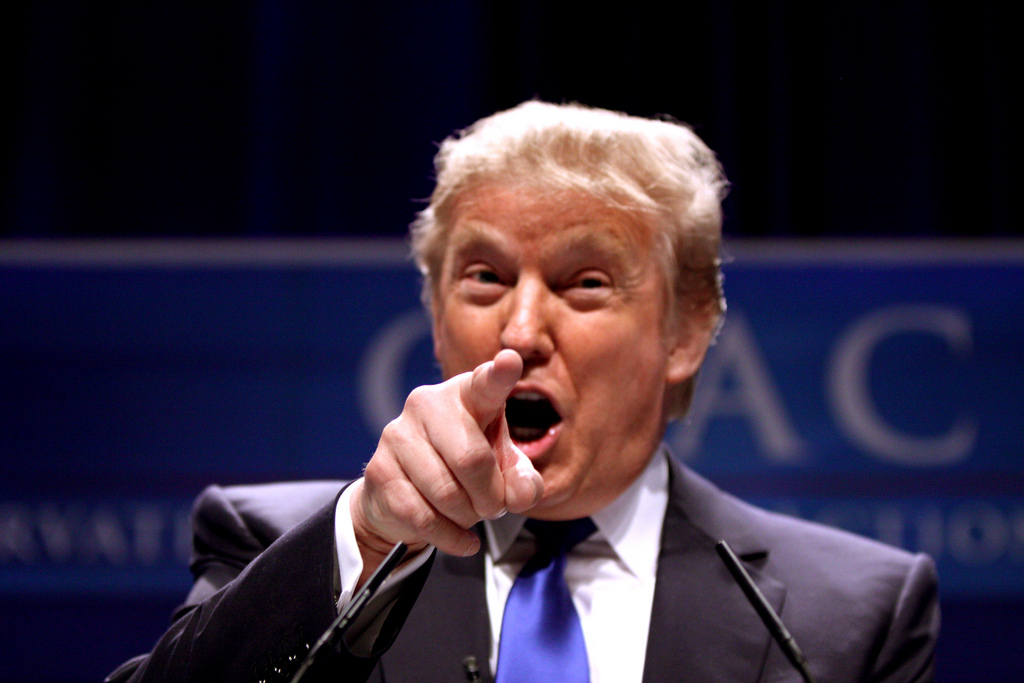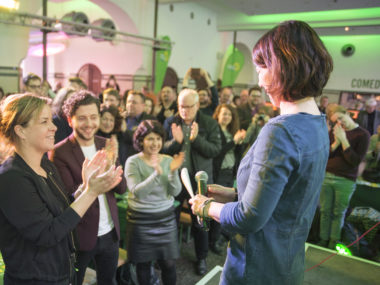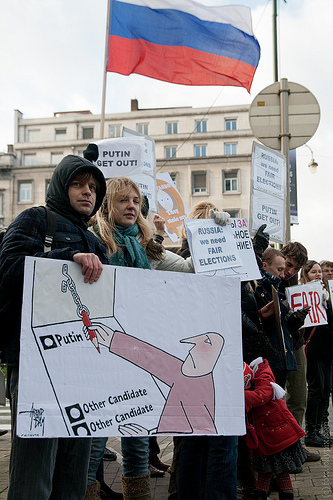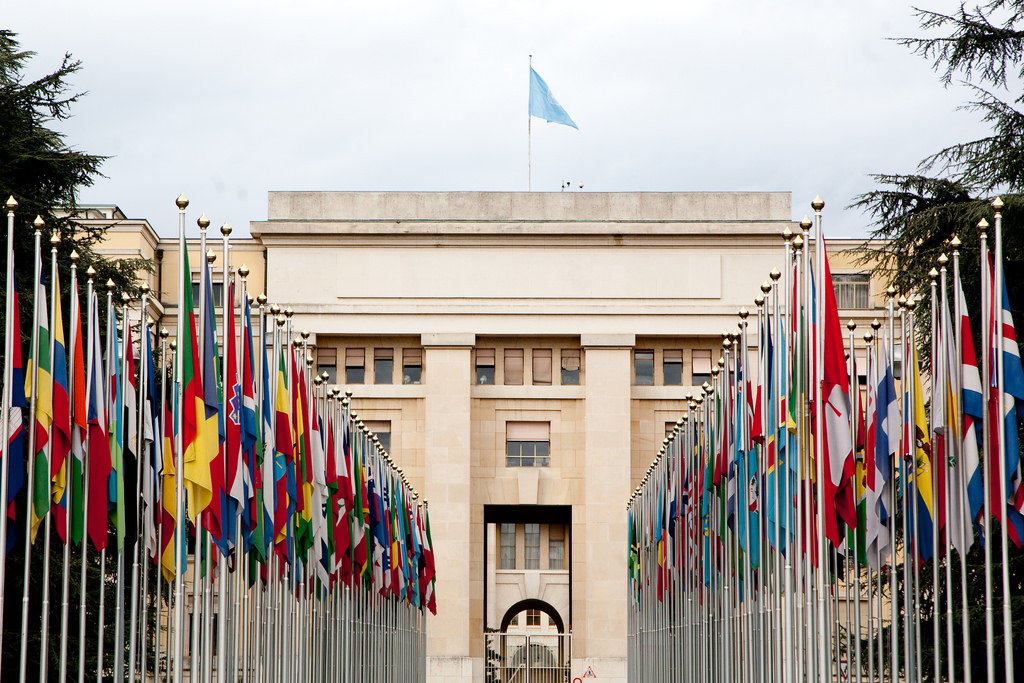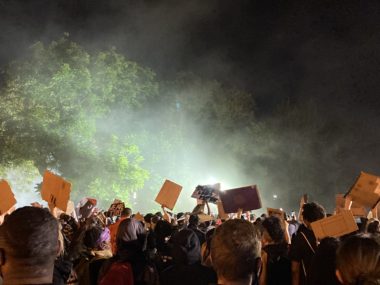By Kathleen Gallagher Cunningham and Caitlin McCulloch.
Why are protestors in Hong Kong apologizing?
Recent photos from the protests in Hong Kong capture the delicate balance that pro-democracy activists need to walk in the era of 24-hour media coverage. While many images feature the protesters engaged in nonviolence targeting at the state, others feature protesters directly engaging the international community. In one such example, two protesters held a banner which read, “Sorry for the inconvenience. We are fighting for the future of our home.” That banner was presumably for the travelers connecting through one of the world’s busiest airports, but it’s later dissemination in a tweet was targeted towards international audiences all across social media.
The sharing of these images, and others like them, come after the protestors have been accused of turning to violence in their pursuit of reforms to Hong Kong’s governing structure. In a notable incident, protestors descended on, tied up, and beat two men suspected of being mainland Chinese agents. Beijing made sure to widely disseminate video of the incident and this video went viral in mainland China, paired with slogans like, “I support Hong Kong police, beat me all you want”, the words that one of the men shouted to those beating him. We now live in a world where protest movements’ actions can be nearly instantly broadcast to an international audience, and people around the world can monitor protests in Venezuela, Puerto Rico, and Hong Kong on a near continuous basis.
Hong Kong protesters and Beijing offer competing narratives of these events. Beijing’s messaging campaign, designed to draw both domestic and international audiences to their side, is built around the protesters’ use of violence. In the words of a top government official, “Beijing hopes that eventually, after a few more weekends of bloody confrontation, public opinion may turn against the radical protesters.” Officials can and do use these videos to support their claims that the protests are led by a small number of violent radicals rather than a large portion of the Hong Kong population. Targeting both mainland and overseas Chinese citizens, Beijing has described protesters as “nothing more than street thugs” and “posted extensive video of protesters purportedly using air guns, slingshots and petrol bombs”.
These messages have successfully stirred both overseas and mainland Chinese communities. Overseas Chinese are preparing to protest the “rioting” in Hong Kong in Sydney. Mainland Chinese audiences are sharing and selling comics and slogans supporting one of the men beaten on Tuesday. This has led to a shift in public opinion that has bolstered both domestic and overseas Chinese support for military intervention into Hong Kong.
Does this messaging about tactics matter to the broader international community?
While Beijing advances a narrative of protester violence, elements of the pro-reform movement in Hong Kong frame their struggle as primarily nonviolent, in both words and deeds. In solidarity against terrorist action, the protests were suspended on September 11th. In recent interviews with political scientists the movement has tried to paint itself as a movement with “self-restraint and solidarity.” A previous research study has shown the negative impact of the use of violence influences international audiences support for such movements.
In our recent study, we explore the impact of both nonviolent and violent tactics on public opinion support of rebel actors. Our experimental research, forthcoming in Research & Politics with Stephen Arves, shows that violent action can heavily shift international public opinion against non-state actors challenging the state and that the competing “non-violent” narrative also holds power.
We employed two survey experiments, one using a national online sample and one using a student sample, to map the response of American public opinion to specific tactics. We provided American respondents with vignettes varying the tactics used by the group and then compared group support and likeability among the respondents. The tactics included terrorism, stone-throwing, nonviolent interventions (such as sit-ins and blockades), social noncooperation (such hunger strikes), and protest demonstrations.
In both studies, nonviolent tactics—specifically demonstrations and hunger strikes—increased support for the opposition actors and the use of violence by these actors decreased support. Additionally, we examined the link between non-state actors’ internal political processes in the form of elections. The respondents’ support for the opposition actors increased when such actors were presented as employing elections internally. This is especially striking given the negative response from states in the face of what they call “illegitimate” elections by nonstate groups (see, for instance, the Abkhazian de-facto state in Georgia).
What does this mean for Hong Kong protesters?
While violence may turn international audiences away, our experimental research also shows that engaging in non-violence can significantly improve public opinion for opposition actors. The protesters in Hong Kong appear to understand this relationship and have taken quick action to try to regain face and apologized for use of violence this past week.
American public opinion generally seems supportive of the protesters. In the words of an opinion columnist at the Philadelphia Inquirer, “Francis Scott Key would probably have loved the pro-democracy protests in Hong Kong.” Further, Hong Kong protests are trying to reach the American Congress so they will pass the Hong Kong Human Rights and Democracy Act, a pro-protestor piece of legislation. Such statements by international actors can serve as a critical shield for protesters.
Protesters are eager to protect this possible support. In the wake of the dissemination of the video of two mainland Chinese men wearing anti-protest t-shirts being beaten, the response, even from a vast and decentralized movement, was quick. Apologies emerged within 24 hours, as the protesters “fought to regain the narrative” around the protests. A prominent figure in the protest movement, Claudia Mo, scolded protesters for their actions, declaring “at a time when the protestors have been trying to garner support from the international community, you would be doing the opposite.”
The struggle for the narrative continues, and as Hong Kong protesters and Beijing compete over international public opinion, it is clear that the further use—or disavowal—of violent tactics will be a deciding factor in who will be the victor. As protesters increasingly turn to violence, setting up barricades and smashing windows, they may be deciding with their actions how likely it is that international publics join them in their calls.
Kathleen Gallagher Cunningham is an Associate Professor in the Department of Government and Politics at the University of Maryland and a regular contributor at PV@Glance. Caitlin McCulloch is a graduate student in the Department of Government and Politics at the University of Maryland.


